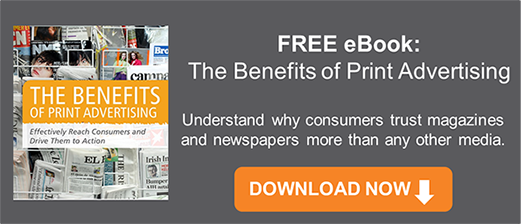We are a society of technologically-obsessed people who aren’t comfortable unless we are constantly connected via some sort of digital device. And, because the entire world has moved online, some in the advertising industry would have you believe print advertising is dead and buried.
But this simply isn’t true.
Print is still very much alive. In fact, advertisers who make print a part of their marketing mix have the potential to significantly increase their response rates. Here are just six advantages of print advertising.
1. Leveraged Credibility
Print publications that consistently offer readers high-quality, reliable content develop credibility, and advertisers can easily leverage this credibility. Known as the “halo effect,” brands who place ads in respected print publications receive the same positive feelings from readers that are associated with the publication itself. This means your ads can be seen as completely trustworthy, which makes generating leads and sales much easier.
2. “Influentials” Are Swayed by Print
An MRI Survey of the American Consumer found that “influentials,” those consumers who have the ability to sway other consumers, are influenced by print ads, with 51% being influenced by magazines and 53% influenced by newspapers.
3. Print Readers Have Bigger Attention Spans
The digital age has pretty much killed the human attention span. We surf the web with six different tabs open while someone is instant messaging us, another is texting us, and “The Walking Dead” is on the TV in the background. We’re simply not as receptive to all of the digital advertising happening around us.
Print readers, on the other hand, don’t typically multitask when they read a magazine or newspaper, making them far more receptive to the ads within the publication.
 4. Unplugging Is In
4. Unplugging Is In
We touched upon the fact that we are tech-obsessed creatures, but we are tech-obsessed creatures who have begun to understand the value of “unplugging” every now and then. When we do unplug from the digital world, we tend to turn to print media as a form of entertainment and engagement.
5. Print Ads Offer More Flexibility and Options
Print ads allow you to target your audience. You can choose exactly which section of the newspaper or magazine your audience is most likely to read. You can choose to run ads in specialty magazines or only in papers that deliver to specific geographic locations in your area. You can choose to have your ads run in Wednesday’s paper or Sunday’s paper.
Beyond these options, print allows you to tailor your campaigns to fit your budget by offering quarter-page, half-page and full-page ads. And finally, advertising in print publications mean you’ll actually work with a human being when buying your ad space as opposed to relying on an online algorithm to decide where your ads should live.
6. Print Ads Drive Action
The Nielson Global Trust reported that 65% of print readers typically take some form of action after viewing a newspaper ad. For example, people who viewed an advertisement from a national grocery chain were six times more likely to buy the product than the retail average.
As we mentioned at the beginning, when print and digital advertising work synergistically, results can be dramatic. The use of QR codes and other interactive features within print ads has helped to create a bridge between the print-digital divide. Ads that include free download offers or social media URLs encourage prospects to engage with brands online and inevitably help to drive more traffic and create awareness.
Successful ad campaigns reach targeted markets, effectively communicate a message, and drive action. By embracing the many advantages of print advertising and adding it to their marketing mix, advertisers can leverage the power of both print and digital to create the most awareness and revenue possible.
RELATED POSTS:
- Hate Wasting Money on Print Advertising? Avoid These 8 Mistakes
- 7 Steps to Profitable Print Advertising
- 5 Reasons Print Media Should Be Part of Your Marketing Mix
Image credit: "Unplug Electrical Devices You're Not Using" by trenttsd is licensed under CC BY 2.0





